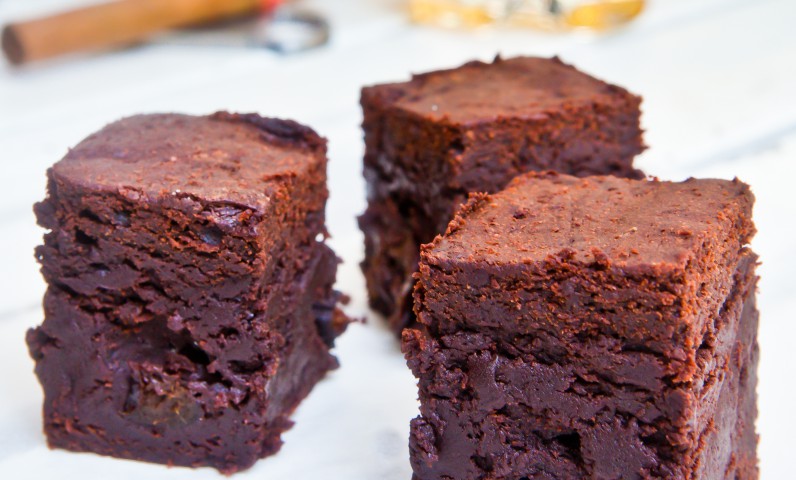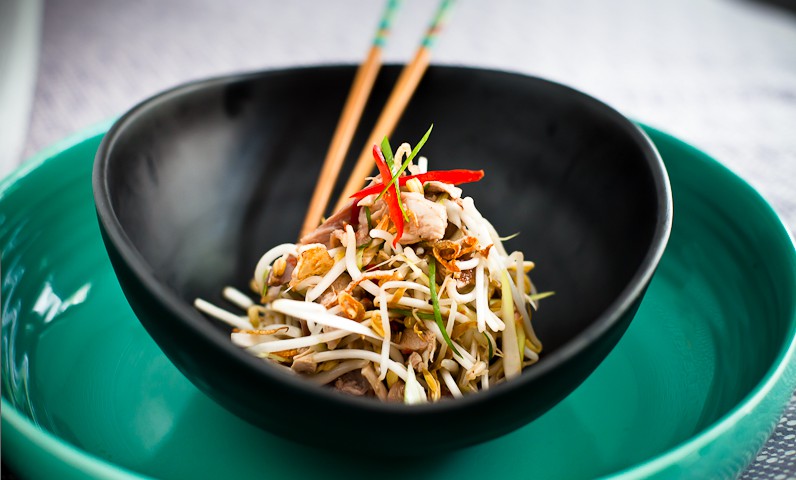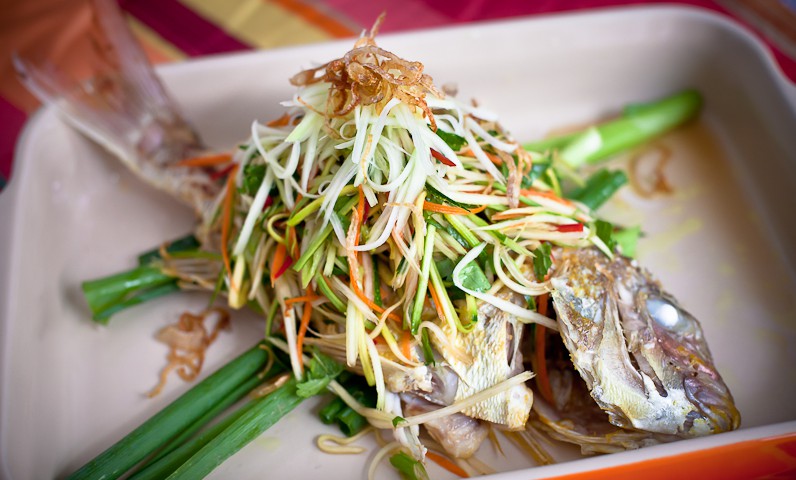
Kung Po Pork
Read more ...Kung Po Pork
25 November 2022I love the simplicity of this dish. The original dish uses chicken but I find pork fillet a great substitute.
INGREDIENTS:
500g pork fillet, sliced1 tbsp plain flour
1 ½ tbsp water
5 tbsp peanut oil
8 small to medium-sized dried red chillies
5cm young ginger, cut into thin strips
½ brown onion, sliced into half-moons
1 tbsp brown sugar
½ cup roasted cashews
2 tbsp soy sauce
1 tbsp Chinkiang Chinese black vinegar
1 tbsp Szechuan pepper, toasted and crushed
METHOD:
In a mixing bowl, marinate pork fillet slices in the flour and water for at least 20 minutes.
Place 2 tbsp oil and chillies in a wok then turn on heat to low. Cook for 2 minutes or until chillies darken in colour. Drain and remove chillies, reserving the oil.
Using the same oil, turn heat to high and fry the pork slices in batches until golden brown (approximately 3-5 minutes). Use extra oil if required. Return all the pork into the wok then add ginger and onion. Cook for 3 minutes.
Add remaining ingredients (except Szechuan pepper) and stir-fry for another 3 minutes. Turn off heat, sprinkle with Szechuan pepper and serve.

Hazelnut Shortbread
Read more ...Hazelnut Shortbread
23 November 2022A Christmas favourite with a nutty twist.
INGREDIENTS:
250g butter, chilled and diced250g plain flour
60g caster sugar, plus extra for dusting
60g hazelnut meal
METHOD:
In a large bowl, combine butter and flour. Rub mixture with your fingers until combined. Mixture should resemble fine crumbs.
Add caster sugar and hazelnut meal and stir to combine.
Pour mixture on a baking tray lined with baking paper. Gather mixture together and pat down to a 25cm-diameter dough. Use a knife and score the shortbread. Rest in the refrigerator for at least 2 hours.
Preheat oven to 160C. Bake for 25 minutes or until light golden.
Remove from oven and allow to cool for 5 minutes on the tray. Dust with caster sugar and allow to cool completely.
Serve with a cup of tea.

Boozy brownies
Read more ...Boozy brownies
22 November 2022The Glen Grant Ten Year Old Single Malt Scotch Whisky recently won Jim Murray’s Whisky Bible 2013 award for the 10 years and under category. Jim Murray says “This has been one of the most consistent Speyside whiskies for a long time. But this year the 10-year-old has excelled to the point of taking the breath away. Obviously very high quality ex-bourbon casks are meeting Glen Grant’s uniquely crisp barley with rare panache. This is a tough category to win, but has done so with aplomb.”
When I was given a bottle of Glen Grant single malt whisky to test, I couldn’t say no. While I’m no cigar-loving whisky connoisseur, I am a firm believer that it goes exceedingly well with dark chocolate.
This is my version of a boozy brownie, adapted from Gourmet Traveller and inspired by Bourke Street Bakery. It’s fudgy with a capital F.
INGREDIENTS:
300g butter, roughly chopped300g good quality dark chocolate, roughly chopped
350g brown sugar
6 medium sized, organic free range eggs
300g plain flour, sifted
120g good quality cocoa sifted
16 pitted prunes
150ml Glen Grant single malt whisky
METHOD:
Soak prunes in whisky for at least 2 days (and no more than 5 days). Drain well.
Preheat oven to 150C.
Melt butter and chocolate in a large bowl over simmering water, stirring until well combined.
Stir in sugar the add eggs one at a time, mixing well after each addition.
Add flour and cocoa and mix until just combined.
Pour half the mixture in a lined 20cm square tin then spread the soaked-prunes. Top with the remaining brownie mixture and bake for at least 45 minutes but no more than 50 minutes.
Allow to cool completely in tin. Cut into squares and enjoy with a glass of Glen Grant.

Mixed berries and rhubarb pie with coconut cream pastry
Read more ...Mixed berries and rhubarb pie with coconut cream pastry
21 November 2022INGREDIENTS:
Coconut Cream Pastry:375g plain flour
105g icing sugar
210g butter, chilled and diced
180g coconut cream
Pie Filling:
375g raspberries
9 stalks rhubarb
1 1/2 punnet blueberries
1 cup caster sugar
3 1/2 tbsp plain flour
Grated lime of 1 lime
Juice of 1 lime
3 tbsp water
METHOD:
Using an electric mixer, pulse plain flour, icing sugar and butter until it resembles rough sand. Alternatively, rub butter into flour with your finger tips until you get the same consistency. Add coconut cream and combine. Tip mixture onto a clean surface and bring together with the heel of your hands until you get a smooth dough. Wrap the dough in some cling film and rest in the refrigerator for 2 hours.
Meanwhile, warm up filling ingredients in a large saucepan until combined and sugar has dissolved. Set aside to cool.
Preheat oven to 180C. Remove the dough from the fridge and divide it in half. Place one half back in the fridge. Using a rolling pin and on a clean, floured surface, roll out the other half of the pastry to a thickness of 5mm. Brush the edge of a 24cm-diameter shallow pie dish with egg wash. Gently place the pastry, lining the bottom and the sides of the dish.
Fill the pie dish with the cooled filling.Roll out remaining dough to the same thickness and cut 2cm strips long enough to span the diameter of the pie dish. You’ll need about 10 strips. Then brush each strip of pastry with egg wash, sprinkle with raw sugar and place on top of filling in a criss-cross pattern. Bake in the oven for 15-20 minutes or until pastry is golden brown.
Allow to cool slightly before serving.

Asian BBQ duck salad with hot, sweet and salty dressing
Read more ...Asian BBQ duck salad with hot, sweet and salty dressing
18 November 2022I love love love Asian BBQ duck. This salad is easy and quick to whip up, and a guaranteed winner. When I am feeling a bit naughty, I would make duck skin croutons by crisping up the duck skin then cutting it up into pieces and stirring it through the salad.
INGREDIENTS:
1 ½ cup shredded Asian BBQ duck50g bean sprouts, trimmed
3 large golden shallots, peeled and thinly sliced
Vegetable oil for frying
1 garlic clove
3 birds eye chillies, roughly chopped
2 tbsp brown sugar
2 tbsp fish sauce
1 tbsp white vinegar
½ cup thinly sliced spring onion
½ wedge of lime (optional)
METHOD:
Heat vegetable oil in a pan and fry shallots until golden and crispy. Drain and set aside, reserving 1 tbsp of the oil.
In the same pan, heat 1 tbsp of the reserved oil and fry the garlic until fragrant. Set aside.
In a mortar and pestle, pound the fried garlic clove with the chillies until you get a rough paste.
Add brown sugar and fish sauce and vinegar and mix well, adjusting the taste to your liking.
In a large bowl, mix the duck and the bean sprouts. Pour in dressing and serve in a bowl topped with fried shallots and spring onion.
Squeeze lime just before serving.

Caramelised Beetroot and Walnut Cake with Butterscotch Sauce
Read more ...Caramelised Beetroot and Walnut Cake with Butterscotch Sauce
18 November 2022To quote Nigel Slater, a beetroot cake “tastes no more of a beetroot than a carrot cake tastes of carrots”. I was given some beetroot so I thought I’d try and create something sweet with it. I’m pleased with the result and I hope you give it a try.
INGREDIENTS:
410g caster sugar1 cup coarsely grated raw beetroot
295g butter
60ml pouring cream
3 free range eggs
225g self-raising flour
½ tsp bicarbonate soda
1 tsp mixed spice
150ml buttermilk
Rind from ½ lemon
1/3 cup roughly chopped walnuts
METHOD:
Preheat oven to 180C. Grease and line a 20cm diameter tin.
To caramelise the beetroot, place 120g caster sugar and 27ml water in a saucepan over medium-high heat. Bring to boil and allow to cook for 4-5 minutes until it starts to change to a golden caramel colour. Carefully add butter and grated beetroot. Cook for another 5 minutes. Remove from heat and allow to cool to room temperature.
To make butterscotch sauce, bring 110g caster sugar and 25ml water to a boil in a saucepan over medium-high heat. Cook for 5-6 minutes or until it changes colour to a dark caramel. Carefully add 120g butter and 25ml water. Once butter is dissolved, add the cream. Stir well and remove from heat. Set aside.
In a bowl, beat the eggs and remaining sugar until pale and creamy (approximately 4 minutes). Fold in the flour, bicarbonate soda, mixed spice, buttermilk, lemon rind, walnuts and caramelised beetroot.
Transfer mixture into the baking tin and bake for 35-40 minutes or until a skewer comes out clean.
Serve with a generous amount of butterscotch sauce.

Chicken broth, kale and zucchini
Read more ...Chicken broth, kale and zucchini
16 November 2022A friend of mine had laryngitis and this was a mercy-run care package I whipped up for her. It’s light and healthy. Kale belongs to the same family as broccoli, cauliflower and Brussels sprouts. It is a rich source of beta carotene, vitamin K, vitamin C and calcium. There are different cultivars – curly leaved, plain leaved and Tuscan kale (also known as cavolo nero). The most common variety of kale, used by many without realising, is gai lan or chinese broccoli.
INGREDIENTS:
1 chicken breast, fat trimmed2 tbsp white miso paste
2 tsp raw sugar
1L chicken stock
1 cinnamon stick
4 cloves
½ tsp cumin
½ fennel seeds
½ tsp black peppercorns
5 star anise
½ tsp coriander seeds
1 small bunch kale, leaves separated from stems, leaves reserved
1 zucchini, finely shredded
3 tbsp fish sauce
25g rock sugar
METHOD:
To poach chicken, combine 1L water, miso paste and raw sugar in a saucepan and bring to boil. Once boiled, slip chicken breast in and cover with a lid. Remove from heat and allow chicken to poach in liquid for 45 minutes. Once cool enough to handle, shred chicken breast and set aside.
Meanwhile, in a square piece of muslin cloth, place cinnamon stick, cloves, cumin, fennel seeds, black peppercorns, star anise and coriander seeds. Tie up the muslin cloth to form a spice pouch.
In another saucepan, add chicken stock and spice pouch and bring to boil. Then add fish sauce and rock sugar.
To serve, place shredded chicken and zucchini in a bowl. Then quickly blanch kale in boiling broth. Add kale to the bowl and ladle a generous amount of broth in the bowl.

Peanut butter fudge brownie
Read more ...Peanut butter fudge brownie
15 November 2022This brownie is incredibly gooey and goes really well with the saltiness of the peanut butter. Use good quality chocolate and you’ll never go wrong.
INGREDIENTS:
500g good quality dark couverture chocolate (containing 60% cocoa solids), roughly chopped170g butter, roughly chopped
1 ½ cups caster sugar
1 tsp salt
4 eggs
2/3 cup plain flour
2 tbsp crunchy peanut butter, melted slightly
METHOD:
Preheat oven to 160C. Grease and line a 20 cm square baking tin.
In a heatproof bowl over simmering water, melt chocolate and butter until smooth and shiny. Remove from heat.
Add sugar and salt and mix until combined. Add eggs one at a time, mixing well after each addition. Add flour and stir until combined.
Pour mixture in baking tin. Dollop melted peanut butter on top of the mixture and using a fork, gently comb the peanut butter through the mixture to create a swirl effect.
Bake for 30-35 minutes. Remove from the oven and allow to cool in tray for another 10 minutes. Turn it out on a wire rack and allow to cool completely before serving.

Deep fried baby snapper with green papaw salad
Read more ...Deep fried baby snapper with green papaw salad
15 November 2022This dish is inspired by a similar dish I had at Red Lantern on Riley. In a lot of Asian cultures, it is good luck to serve fish whole. And out of respect for the elders, the head of the fish should always point in their direction on the dinner table.
A tip I learnt from Sydney Fish Market – always make sure you measure the size of your wok so you get the right size fish that fits.
INGREDIENTS:
Peanut oil for deep frying1 small whole snapper (to fit a large wok), scaled and scored deeply on both sides
1 tbsp plain flour
1 tsp sea salt flakes
½ tsp turmeric
1 green papaw peeled and shredded
5 spring onions (scallions), sliced finely
1 large red chilli, deseeded and sliced finely
½ zucchini, julienned
½ carrot, julienned
¼ cup coriander leaves, roughly chopped
¼ cup mint leaves, roughly chopped
3 tbsp lime juice
3 tbsp brown sugar
3 tbsp fish sauce
2 tbsp sesame oil
Fried shallots for garnish
METHOD:
Heat oil in the wok until it reaches 180C.
In a bowl, mix flour, sea salt and turmeric. Coat snapper with flour mix then gently lower snapper into hot oil. Cook for 6-8 minutes or until golden. Remove from hot oil and set aside on a paper towel to drain.
In a large mixing bowl, combine green papaw, spring onions, chilli, zucchini, carrot, coriander and mint leaves.
To make the dressing, combine lime juice, palm sugar, fish sauce and sesame oil in a mixing bowl. Dress the salad then pour over fish and garnish with fried shallots.

Bibimbap
Read more ...Bibimbap
15 November 2022Bibimbap literally translates to ‘mixed rice’. A Korean favourite, this has become a staple in my household. The mise en place is fairly extensive but the end result is well worth it. There are many variations of this dish but my favourite is the ‘dolsot bibimbap’ where the meal is served in a hot stone bowl. Mix all the ingredients together or pick each carefully arranged vegetables at your own time, the bibimbap always warms up my winter nights. This dish can be served in a standard bowl or you can choose to use a preheated stone bowl.
Image and styling courtesy of Blanco Australia
INGREDIENTS:
Steak600g flank steak
½ tsp minced garlic
½ tsp ground white pepper
½ tsp sugar
1 tsp sesame oil
2 tsp soy sauce
1 tbsp Shao Xing wine
Vegetables
2 medium-sized zucchini, cut into wide long strips, approx. 6-8cm in length
2 tbsp fish sauce
2 tbsp vegetable oil
2 tsp garlic
2 medium-sized carrots, julienned
1 ½ tsp salt
1 ½ tsp sugar
500g bean sprouts, blanched
10 fresh shiitake mushrooms, sliced
1 bunch spinach, blanched
1 tsp sesame oil
1 tsp white sesame seeds, lightly toasted
4 eggs
3 cups cooked short grain rice
Korean chilli paste
METHOD:
Steak
Marinate steak with garlic, white pepper, sugar, sesame oil, soy sauce and Shao Xing wine. Set aside for 30 minutes.
Heat a pan to high. Remove steak from the marinade, draining excess liquid, and cook steak to your liking (I prefer medium rare). Allow steak to rest before slicing it thinly.
Vegetables
Zucchini:
Combine zucchini with fish sauce and allow to marinate for 10 minutes. Heat up one tablespoon of vegetable oil and sauté 1 teaspoon of garlic for 30 seconds. Squeeze access fish sauce out of zucchini then fry zucchini in hot oil for 2 minutes. Set aside.
Carrots:
Gently rub the carrots with salt and sugar. Set aside for 30 minutes then squeeze and drain excess liquid. Set aside.
Mushrooms:
Heat remaining oil and sauté remaining garlic. Fry shiitake mushrooms for 2 minutes or until softened then set aside.
Spinach:
Combine spinach with sesame oil and mix in sesame seeds. Set aside.
To poach the eggs in their shell, bring a pot of salted water to boil. Gently lower the eggs into the water and when the water returns to a boil, reduce the heat and allow to simmer for 6 minutes. Drain and carefully peel the shells. Set aside.
To assemble your bibimbap, place a serving of rice in a bowl and carefully arrange all the ingredients around the rice and gently place the poached egg on top of the rice. Serve hot with a dollop of Korean chilli paste.
NOTE: If you are using stone bowls, heat them up in an oven preheated to 180C. Carefully remove them and place them on their trivets. Brush one teaspoon of sesame oil on the base of each bowl and start assembling your bibimbap as above.